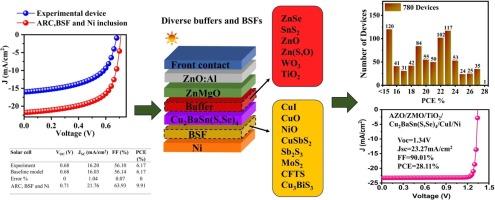通过模拟优化 Cu2BaSn(S,Se)4 太阳能电池中的缓冲区和底部叠层来提高效率
IF 5.8
2区 材料科学
Q2 CHEMISTRY, PHYSICAL
引用次数: 0
摘要
与 Cu2ZnSn(S,Se)4 相比,Cu2BaSn(S,Se)4 具有无毒性、地球丰度和较低的反斜长石缺陷,因此作为一种潜在的吸收剂受到了极大的关注。然而,Al:ZnO/Mg:ZnO/Zn1-xCdxS/Cu2BaSn(S,Se)4/Mo 器件结构的最高实验效率为 6.17%。因此,找到一种合适的无毒缓冲器并对底部堆栈进行改性至关重要。为此,我们使用 SCAPS-1D 对基于不同缓冲器的 Cu2BaSn(S,Se)4 太阳能电池进行了数值模拟,将 Ni 作为背接触,并在吸收器/Ni 界面引入背表面场 (BSF)。首先,设计了一个验证实验效率的基线模型。由于形成了欧姆接触,镍的应用将效率提高到 7.92%。此外,使用抗反射涂层后,效率提高到 9.91%。随后,通过优化吸收器、缓冲器和界面特性,共设计出 780 个太阳能电池,其中有 6 种缓冲器和 8 种 BSF 组合,AZO/ZMO/TiO2/Cu2BaSn(S,Se)4/CuI/Ni 太阳能电池的效率最高,达到 28.11%,填充因子高达 90%,VOC 损失更小(0.24 V)。此外,还通过能带图、莫特-肖特基图和奈奎斯特图分析了 BSF 的重要性。研究结果表明,BSF 对太阳能电池的能带排列、内置电势、耗尽宽度和重组电阻有很大影响,突出了其在提高性能方面的重要性。总之,本研究提出了一种改变 Cu2BaSn(S,Se)4 太阳能电池器件配置以提高其效率的有效策略。本文章由计算机程序翻译,如有差异,请以英文原文为准。

Boost efficiency with buffer and bottom stack optimization in Cu2BaSn(S,Se)4 solar cells by simulation
Cu2BaSn(S,Se)4 is gaining tremendous attention as a potential absorber due to its non-toxicity, earth abundance, and low antisite defects opposing Cu2ZnSn(S,Se)4. However, the highest experimental efficiency of 6.17% is achieved with the device structure Al:ZnO/Mg:ZnO/Zn1-xCdxS/Cu2BaSn(S,Se)4/Mo where the drawback is large open circuit voltage (VOC) loss stemming from the large cliff at the absorber/buffer interface and back contact recombination. Therefore, finding a suitable non-toxic buffer with modification of the bottom stack is crucial. In this regard, Cu2BaSn(S,Se)4 solar cells based on diverse buffers are numerically simulated using SCAPS-1D with Ni as back contact and introducing back surface field (BSF) at the absorber/Ni interface. At first, a baseline model validating the experimental efficiency is designed. The application of Ni enhanced efficiency to 7.92% due to the formation of ohmic contact. Further, it is improved to 9.91% with anti-reflection coating. Afterward, a total of 780 solar cells were designed with six buffer and eight BSF combinations by optimizing the absorber, buffer, and interface properties where the highest efficiency of 28.11% with incredible fill factor (90%) and less VOC loss (0.24 V) is accomplished for the AZO/ZMO/TiO2/Cu2BaSn(S,Se)4/CuI/Ni solar cell. Further, the importance of BSF is analyzed via energy band diagrams, Mott-Schottky and Nyquist plots. The outcomes disclosed that the BSF greatly influences the energy band alignment, built-in potential, depletion width, and recombination resistance of solar cells, underscoring its significance in improving performance. Overall, the present work proposes an efficient strategy to modify the device configuration of Cu2BaSn(S,Se)4 solar cells to enhance their efficiency.
求助全文
通过发布文献求助,成功后即可免费获取论文全文。
去求助
来源期刊

Journal of Alloys and Compounds
工程技术-材料科学:综合
CiteScore
11.10
自引率
14.50%
发文量
5146
审稿时长
67 days
期刊介绍:
The Journal of Alloys and Compounds is intended to serve as an international medium for the publication of work on solid materials comprising compounds as well as alloys. Its great strength lies in the diversity of discipline which it encompasses, drawing together results from materials science, solid-state chemistry and physics.
 求助内容:
求助内容: 应助结果提醒方式:
应助结果提醒方式:


